Exercises (3201)
Move upper leg forwards in lateral support (left) ► knee raise lateral pillar bridge / side bridge
Power
Individual work


Lateral support with outstretched (left) arm, push the thigh of the upper leg straight out forwards (lower leg parallel, thigh bent at approx. 90 degrees to the body/leg) and return to the starting position.
Attention:
Head, torso, hips and knees practically form a line (pelvis does not tilt backwards or forwards), keep shoulder above elbow.
Lighten:
Knee on the floor; move your leg less forwards; just hold the position.
Harden:
Additional weight (for the free leg or on the hip); unstable support (possible for both the arm and the leg).
1 weight cuff/weight vest/weight disc/sandbag ► to make the exercise more difficult (additional weight)
1 ball/1-2 balance cushions ► to make the exercise more difficult (unstable surface)
Move upper leg forwards in lateral support (right) ► knee raise lateral pillar bridge / side bridge
Power
Individual work


Lateral support with outstretched (right) arm, push the thigh of the upper leg straight out forwards (lower leg parallel, thigh bent at approx. 90 degrees to the body/leg) and return to the starting position.
Attention:
Head, torso, hips and knees practically form a line (pelvis does not tilt backwards or forwards), keep shoulder above elbow.
Lighten:
Knee on the floor; move your leg less forwards; just hold the position.
Harden:
Additional weight (for the free leg or on the hip); unstable support (possible for both the arm and the leg).
1 weight cuff/weight vest/weight disc/sandbag ► to make the exercise more difficult (additional weight)
1 ball/1-2 balance cushions ► to make the exercise more difficult (unstable surface)
Move upper body forwards and backwards in forearm support ► dynamic pillar bridge
Power
Individual work


Underarm support (the outstretched legs and upper body practically form a line, the legs are supported on the tips of the toes and the upper body on the forearms, the forearms lie flat on the floor parallel to each other, the upper arms are vertical), move the upper body forwards and backwards by changing the angle between the forearm and upper arm.
Attention:
Head, torso, hips and knees practically form a line (do not stretch your buttocks upwards or let them sag, tense your stomach).
Lighten:
Knees on the floor (kneeling shift).
Harden:
Additional weight (on the back); unstable support for the legs and/or arms possible.
1 weight vest/weight disc/sandbag ► make the exercise more difficult (additional weight)
1 ball/1-2 balancing cushions/balance board ► make the exercise more difficult (unstable surface)
Orientation artist
Coordination exercises
Partner work
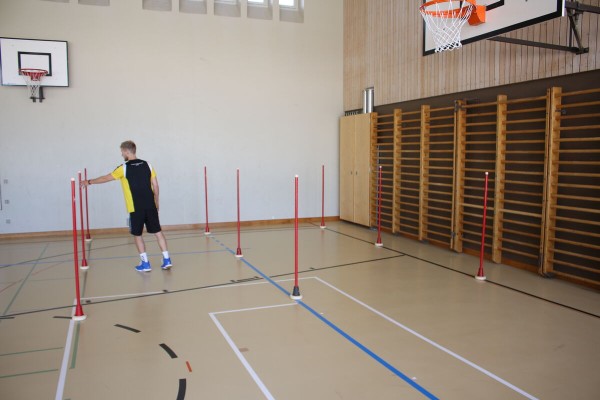
One participant gives their partner a route to run around the stakes to the opposite side. With their eyes closed, they try to run the specified route. After feedback on the execution of the exercise, the roles are swapped.
Variant:
Individual work: the participant imagines a route for themselves and tries to complete it with their eyes closed (blind route).
►Orientation skills
9 stakes
Post setup:
Place the stakes in a rectangle (3x3).
Orienteering
Orienteering
Single run or groups of 2/3
Send participants/groups onto the course in staggered formation (note the distance to the first starter/starting group on the run card)
In the terrain, the sports leader distributes the control points in advance, which the participants then approach individually or in small groups during the orienteering run. Participants receive an overview of the posts and a route map. The participants decide for themselves the order in which they mark off the controls (or the order can also be defined). The orienteering run can be carried out both as an exercise and as a competition. It is worth staggering both variants so that each participant/group has to work independently and does not simply follow a forerunner/group (note the time intervals/difference to the first start time on the run card for the evaluation). The control overview with the running map can either be handed out together with the start signal or distributed to the runners/groups a certain time before the start. For the orienteering run, each participant/group has a defined amount of time to find as many or as many controls as possible.
Variant:
Prepare the control transfer point: The participants do not receive a map on which the controls are already marked, but must mark the controls themselves at a control transfer point (e.g. using coordinates, azimuth or measuring point method). The control sheets remain at the start even after the transfer. Before the participants set off on the course, the sports director checks the marked controls.
Orienteering controls (to be unplugged)
1 stopwatch
Participant/group:
1 orienteering map with control overview incl. designation (prepared in advance by the sports director)
1 running map form 30.063
1 bussole
Variation of the exercise:
Participant/group:
1 control transfer sheet
1 map scale
1 pencil and eraser
Pair catching
Stimulate circulation
Group work
Groups of 2
Two players form a team. They are connected to each other with a rope, which they wrap once around their wrist (or simply hold the rope) or by holding a stick (Siamese twins). The binomial must never let go of the rope/stick. One pair (labelled with bibs) chases the other pairs. If a pair is caught, the roles (hunter & catcher) are swapped. The game can also be played with several pairs of catchers.
Variant:
Fix the legs of the pairs together with the rope.
Per group of 2:
1 skipping rope/stick ►Intercrosse/lacrosse, floorball, Nordic walking
2-6 game ribbons/leashes ►catcher (variant)
Parkour
Parkour
Group work
Various equipment/posts are distributed around the hall (e.g. uneven bars, horizontal bars at different heights, wall bars, vaulting box, soft mats, horse, etc.). The participants think independently about how to pass/overcome the obstacles and put together a small course. After a short preparation time, each participant demonstrates their run to the rest of the group.
According to the selected item selection
Partner massage
Regeneration
Partner work
Groups of 2
The participants perform massages with a tennis ball or throwing body on their partner. During the circular movements with the ball, the circumference (small-large) and the pressure (no pressure on joints) are varied.
Participant in supine position, massage by partner of:
- Front thigh muscles
- Abdominal muscles
- Chest muscles
- Arms
Participant in prone position, massage by partner of:
- Calf muscles
- Back thigh muscles
- Buttock muscles
- Back muscles
- Arms
Per group:
1 tennis ball
1 soft mat
Partner massage
Regeneration
Partner work
Groups of 2
The partner massages the tense muscle areas with the following hand movements in the following order:
- Stroking: Repeated stroking with the flat of the hands towards the heart;
- Kneading: Repeated one-handed, two-handed or finger kneading, return with light stroking
- Stroking
- Pressing: place hand flat on skin and press evenly without sliding. Release and repeat; stroking;
- Stroking
- Walking: "nettle technique". Place your hands flat and pull them against each other over the tissue
- Stroking
Per group
1 soft mat (small)
Partner tracking
Increase pulse
Partner work
Groups of 2
Two participants stand, lie, sit or kneel behind each other in a line at a distance of approx. 1-2 metres. The hands are placed on the back. At a signal from the sports leader, the participant in the back tries to catch the participant in front in front of a defined line. The roles are swapped on the next pass.
Possible start signals:
Acoustic:
- Call from the sports leader
- Tambourine
- Start music
Visual:
- Coloured cloths/hats (one colour is the start)
- Sports leader gives a signal (e.g. raise/lower arms).e.g. raise/lower arms, show number of fingers)
According to signal selection:
1 music system with music
2 drumsticks
1 tambourine
4 cloths/caps
Passport stress
Stimulate circulation
Partner work
The pair stand opposite each other (facing their partner). A distance of approx. 3-4 metres is maintained between the binomial. The binomial tries to string together 10 successful passes as quickly as possible. A pass is successful if the throwing disc (the frisbee), the ball (with the playing equipment) is caught or the shuttle (ball) is returned correctly. If a mistake is made (the disc or the ball/shuttle falls to the ground), the count starts again. The distance can be varied as desired after a successful attempt.
Variant I:
Multiple groups of 2 compete against each other (2 rows). The winning binomial is the one that is the first to string together 10 successful passes after the sports director's start signal. After each pass, the distance is increased (one row moves back 1-2 steps).
Variant II:
The sports leader specifies a throwing/striking/passing technique, provided that the individual techniques have already been practised.
Per participant:
1 bat/stick ► Intercrosse/Lacrosse, Smolball, Floorball, Badminton/Speedminton
Per group of 2:
1 disc (Frisbee)/ball/shuttle ► Frisbee Ultimate, Basketball, Blitzball/Rugby/Football, FooBaSKILL, Futsal/Football, Handball, Intercrosse/Lacrosse, Smolball, Floorball, Volleyball, Badminton/Speedminton
Passport stress
Forms of play / exercises
Partner work
The pair stand opposite each other (facing their partner). A distance of approx. 3-4 metres is maintained between the binomial. The binomial tries to string together 10 successful passes as quickly as possible. A pass is successful if the throwing disc (the frisbee), the ball (with the playing equipment) is caught or the shuttle (ball) is returned correctly. If a mistake is made (the disc or the ball/shuttle falls to the ground), the count starts again. The distance can be varied as desired after a successful attempt.
Variant I:
Multiple groups of 2 compete against each other (2 rows). The winning binomial is the one that is the first to string together 10 successful passes after the sports director's start signal. After each pass, the distance is increased (one row moves back 1-2 steps).
Variant II:
The sports leader specifies a throwing/striking/passing technique, provided that the individual techniques have already been practised.
Per participant:
1 bat/stick ► Intercrosse/Lacrosse, Smolball, Floorball, Badminton/Speedminton
Per group of 2:
1 disc (Frisbee)/ball/shuttle ► Frisbee Ultimate, Basketball, Blitzball/Rugby/Football, FooBaSKILL, Futsal/Football, Handball, Intercrosse/Lacrosse, Smolball, Floorball, Volleyball, Badminton/Speedminton
Passport stress
Forms of play / exercises
Partner work
The pair stand opposite each other (facing their partner). A distance of approx. 3-4 metres is maintained between the binomial. The binomial tries to string together 10 successful passes as quickly as possible. A pass is successful if the throwing disc (the frisbee), the ball (with the playing equipment) is caught or the shuttle (ball) is returned correctly. If a mistake is made (the disc or the ball/shuttle falls to the ground), the count starts again. The distance can be varied as desired after a successful attempt.
Variant I:
Multiple groups of 2 compete against each other (2 rows). The winning binomial is the one that is the first to string together 10 successful passes after the sports director's start signal. After each pass, the distance is increased (one row moves back 1-2 steps).
Variant II:
The sports leader specifies a throwing/striking/passing technique, provided that the individual techniques have already been practised.
Per participant:
1 racket/stick ► Intercrosse/Lacrosse, Smolball, Floorball, Badminton/Speedminton, Street Racket
Per group of 2:
1 throwing disc (Frisbee)/ball/shuttle ► Frisbee Ultimate, Basketball, Blitzball/Rugby/Football, FooBaSKILL, Futsal/Football, Handball, Intercrosse/Lacrosse, Smolball, Floorball, Volleyball, Badminton/Speedminton, Street Racket
Fits
Stimulate circulation
Group work
4-6 participants per group
All participants move freely in the hall/area. Within the group, the participants pass a ball/throwing disc to each other. The sports leader can specify types of pass (e.g. ground pass, high pass, inside and outside instep, backhand, forehand, etc.) and throwing disc/ball receptions (e.g. one/two-handed catching, receiving with the sole of the foot, etc.). The exercise is then rearranged so that one group (e.g. blue) plays the ball/throwing disc to the other group (e.g. red) and in turn receives the ball/throwing disc from another group (e.g. green). The sports leader can integrate additional balls/throwing discs into the exercise.
Variant:
If the sports leader calls out the colour of a group with the addition "column" (e.g. "blue column"), the called group lines up in a row facing the back of the person in front (distance between the participants approx. 1-2 metres). Next, the sports leader calls a command for another group (e.g. command "red slalom"), which performs a movement task with the ball/throwing disc around the group lined up in column (e.g. bouncing the ball, guiding the ball with the feet or balancing the ball on a piece of equipment). The participant who has passed the slalom then passes the ball back to the next group member (e.g. past the lined-up group or between the spread legs). Once all group members have completed the slalom, all participants move freely around the hall/area again.
Per participant:
1 stick/stick ►intercrosse/lacrosse, smolball, floorball
1 wristband/stick ►team identification
Per group:
1 ball/throwing disc (Frisbee) ►Basketball, Frisbee Ultimate, FooBaSKILL, Futsal/Football, Handball, Intercrosse/Lacrosse, Smolball, Tchoukball, Floorball
Sports leader:
x additional balls/throwing discs (optional)
Fits
Forms of play / exercises
Group work
4-6 participants per group
All participants move freely in the hall/area. Within the group, the participants pass a ball/throwing disc to each other. The sports leader can specify types of pass (e.g. ground pass, high pass, inside and outside instep, backhand, forehand, etc.) and throwing disc/ball receptions (e.g. one/two-handed catching, receiving with the sole of the foot, etc.). The exercise is then rearranged so that one group (e.g. blue) plays the ball/throwing disc to the other group (e.g. red) and in turn receives the ball/throwing disc from another group (e.g. green). The sports leader can integrate additional balls/throwing discs into the exercise.
Variant:
If the sports leader calls out the colour of a group with the addition "column" (e.g. "blue column"), the called group lines up in a row facing the back of the person in front (distance between the participants approx. 1-2 metres). Next, the sports leader calls a command for another group (e.g. command "red slalom"), which performs a movement task with the ball/throwing disc around the group lined up in column (e.g. bouncing the ball, guiding the ball with the feet or balancing the ball on a piece of equipment). The participant who has passed the slalom then passes the ball back to the next group member (e.g. past the lined-up group or between the spread legs). Once all group members have completed the slalom, all participants move freely around the hall/area again.
Per participant:
1 stick/stick ►intercrosse/lacrosse, smolball, floorball
1 wristband/stick ►team identification
Per group:
1 ball/throwing disc (Frisbee) ►Basketball, Frisbee Ultimate, FooBaSKILL, Futsal/Football, Handball, Intercrosse/Lacrosse, Smolball, Tchoukball, Floorball
Sports leader:
x additional balls/throwing discs (optional)
Fits
Stimulate circulation
Partner work
Two participants face each other and pass the ball/shuttle to each other. The distances and types of pass (e.g. high pass, backhand, forehand, etc.) are varied.
The exercise can be performed with either the stronger or weaker hand.
Per participant:
1 racket ►smolball, badminton/speedminton
Per group of 2:
1 ball/shuttle ►smolball, badminton/speedminton
Fits
Stimulate circulation
Partner work
Two participants stand opposite each other and pass the ball/throwing disc to each other. The distances, types of pass (e.g. ground pass, high pass, inside and outside instep, backhand, forehand, overhead throw, etc.) and throwing disc/ball reception (e.g. one/two-handed catch, reception with the sole of the foot, sandwich catch, etc.) are varied. After the static form, the participants move freely around the hall/area and pass the ball/throwing disc to each other while moving.
It is important to ensure that the exercise is performed with both the stronger and weaker hand (ditto foot).
Variant I:
Include challenging trick throws/shots.
Variant II:
The two participants each throw/pass a ball/disc (frisbee) to their partner at the same time, whereby it should be agreed who throws/passes their ball/disc at which height/side.
Per participant:
1 stick/stick ►intercrosse/lacrosse, smolball, floorball
Per group:
1 ball/throwing disc ►basketball, Frisbee Ultimate, FooBaSKILL, futsal/football, handball, intercrosse/lacrosse, smolball, tchoukball, floorball
1 additional ball/throwing disc (Frisbee) ►variant
Passives Stretching
Stretching
Individual work
Stretch the following muscle groups (without rocking movements):
- Calf muscles
- Thigh muscles
- Gut muscles
- Abductors
- Adductors
- Belly muscles
- Back muscles
- Chest muscles
- Shoulder muscles
- Arm extensors
- Arm flexors
- Neck muscles
.
Variant:
In place of the exercise leader, one participant gives the exercise. After each exercise, another participant takes on the role of leader
No material required
Passives Stretching
Stretching
Partner work
Stretch the following muscle groups together with your partner (without rocking movements):
- Calf muscles
- Thigh muscles
- Buttock muscles
- Abductors
- Adductors
- Abdominal muscles
- Back muscles
- Chest muscles
- Shoulder muscles
- Arm extensors
- Arm flexors
- Neck muscles
.
Variation:
In place of the exercise leader, one participant gives the exercise. After each exercise, another participant takes on the role of leader
No material required
Passives Stretching
Stretching
Individual work
Stretch the following muscle groups using an aid (without rocking movements):
- Calf muscles
- Thigh muscles
- Gut muscles
- Abductors
- Adductors
- Abdominal muscles
- Back muscles
- Chest muscles
- Shoulder muscles
- Arm extensors
- Arm flexors
- Neck muscles
Variation:
In place of the exercise leader, one participant gives the exercise. After each exercise, another participant takes on the role of leader
Per Tn:
1 ball ► Basketball, Blitzball/Rugby/Football, Fistball, Futsal/Football, Handball, FooBaSKILL, Volleyball
1 stick ► Floorball, Intercrosse/Lacrosse, Nordic walking
1 racket ►badminton/speedminton, smolball
1 throwing disc (frisbee) ►frisbee ultimate
1 elasticated rubber band/gym stick with elastic band/stretch tube/skipping rope/spinbond
Passives Stretching
Stretching
Partner work
Stretch the following muscle groups together with your partner using an aid (without rocking movements):
- Calf muscles
- Thigh muscles
- Gut muscles
- Abductors
- Adductors
- Abdominal muscles
- Back muscles
- Chest muscles
- Shoulder muscles
- Arm extensors
- Arm flexors
- Neck muscles
Variant:
In place of the exercise leader, one participant gives the exercise. After each exercise, another participant takes on the role of leader
Per group of 2:
1 ball ► Basketball, Blitzball/Rugby/Football, Fistball, Futsal/Football, Handball, FooBaSKILL, Volleyball
1 stick ► Floorball, Intercrosse/Lacrosse, Nordic walking
1 racket ►badminton/speedminton, smolball
1 throwing disc (frisbee) ►frisbee ultimate
1 elasticated rubber band/gym stick with elastic band/stretch tube/skipping rope/spinbond
Passive stretching: adductors
Stretching
Individual work
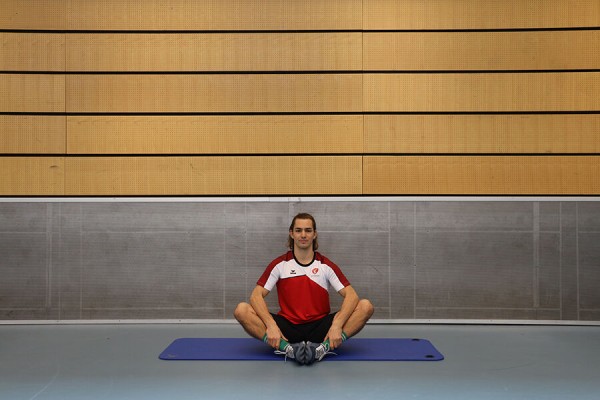
Sit upright, bend your legs and place the soles of your feet flat against each other in front of your body. Use your hands to pull your feet towards your body and press your elbows on the inside of your knees (press your knees towards the floor). Keep your upper body upright.
No material required
Passive stretching: adductors
Stretching
Partner work
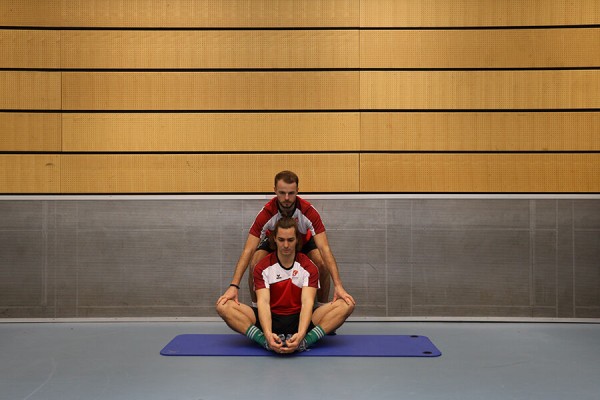
Sit upright, bend your legs and place the soles of your feet flat against each other in front of your body. Use your hands to pull your feet towards your body, keeping your upper body upright. The partner stands behind the seated participant and presses the knees lightly to the floor (adjust the intensity to the partner). The position is then changed.
No material required
Passive stretching: adductors
Stretching
Individual work
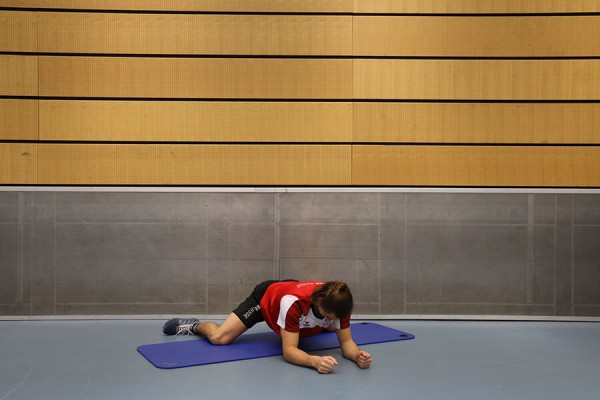
Stand on four feet, supporting yourself on your knees and hands. Then stand on your forearms and let your legs move outwards, pushing your buttocks backwards. Move your hips towards the floor. From time to time, you can try to spread your legs a little further outwards.
No material required
Passive stretching: adductors / back muscles (below)
Stretching
Individual work
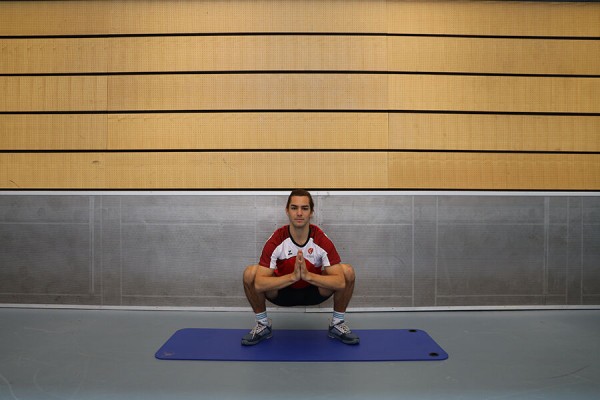
Squat low (buttocks below the knees), feet pointing slightly outwards, back straight (upper body leaning slightly forwards), use your elbows to push your knees slightly outwards.
No material required